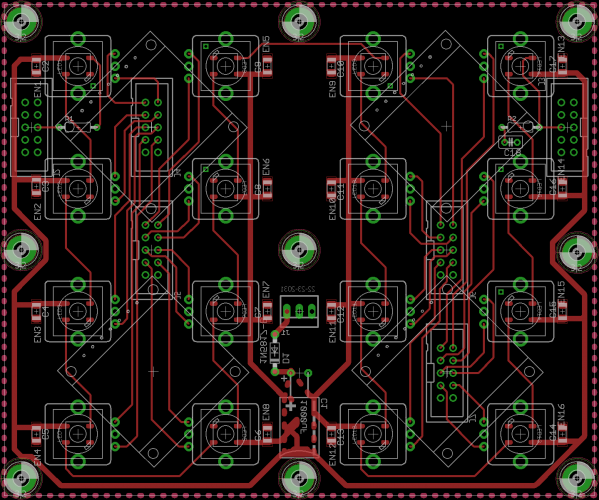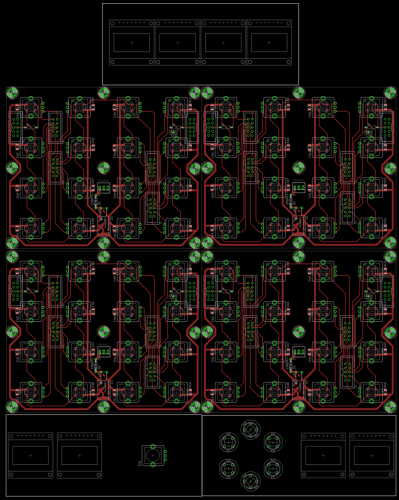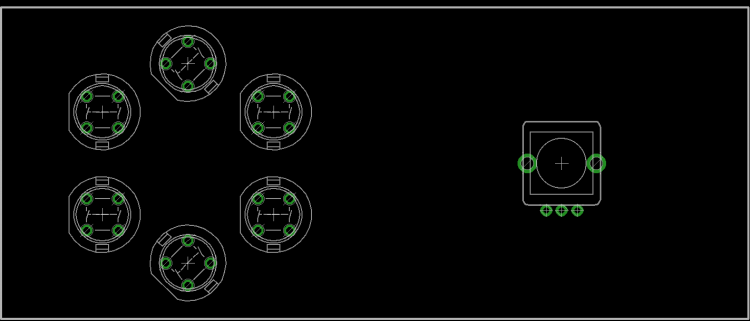-
Posts
2,524 -
Joined
-
Last visited
-
Days Won
149
Content Type
Profiles
Forums
Blogs
Gallery
Everything posted by latigid on
-
First off, did you upload the correct firmware using the Wilba variant?
-
Looks nice! Is there a current method of using touch sensors for the faders on a 32-bit Core? We're missing the J14 strobe line present on the old PIC Core. Seems to have been ported in software at least.
-
They're very useful and cost 1 cent for 1000 :). If you ever go for the full SEQ BLM that's 1/3rd gone!
-
Hello again :) No problem to use the switch as an input for a DIN. Just connect one side to ground and the other to the appropriate pin on the module. There's no need for diodes unless you're configuring a switch matrix.
-
According to adafruit, there are at least two LEDs with different names that use the same controller (or an equivalent). I think they should work; you should choose the 5mm LED as 8mm is too large. At some point I will sell the PCBs to suit (don't buy Sparkfun PCBs unless you want to use common RGB LEDs), price should be about 8 EUR. If you read through TK.'s code example on svnmios32, he states that driving the LEDs takes up quite a bit of memory but not too much CPU overhead. There is a limit in the chain length in order to guarantee data transmission. I'm pretty sure that the controllers hold the colour value and new data is only required for updates. The advantage of shift registers is the parallel data transmission which allows for a simple serial stream to rapidly clock multiple lines. Disadvantages are the complicated PCB and software matrices, but it does work (BLM 16*16+X). Bon weekend,
-
If you can verify that the hex is written, it should be okay. I think the point of selecting the device (manually) is that the burner knows what programming voltage to use.
-

MB-6582 with external Power supply using power switch from the kit
latigid on replied to Psykhaze's topic in MIDIbox SID
Did you find the build guide page? http://www.midibox.org/dokuwiki/doku.php?id=wilba_mb_6582_base_pcb_construction_guide You want to follow "Power Option D" http://www.midibox.org/dokuwiki/lib/exe/fetch.php?media=mb-6582:mb-6582_base_pcb.pdf This is the PCB layout, so you should either jumper pins on the power switch directly to J4 or add bridges e.g. to bypass the 9V regulator. Hope that helps, -
DOUT can also provide a type of PWM, but it only works well when the LEDs are addressed individually (i.e. not in a matrix). Which means quite a lot of DOUT pins. A better method is to use WS2812 LEDs which respond to a serial data chain. See the end of that thread for working layouts with 4*4 Sparkfun button pads and illuminated encoders.
-
Apparently you have to set the LXR BPM to 0 to slave to an external clock, it sounds like the LXR is getting confused with two clock sources. http://wiki.sonic-potions.com/index.php/LXR_Owners_Manual#MIDI_clock_sync
-
Just to clarify; do you think the three rectangular boards (4*OLED; 2*OLED, 1 enc; 6*buttons 2*OLED) are too far away from the encoders? I have the 4*4 illuminated encoder boards already, but my idea was to create another PCB which holds 4*OLEDs mounted at 45 degrees as per the Programma design, which is stacked over the encoder board. So I think that's what you suggest: displays mounted as close as possible to encoders? Sorry if that's confusing, the rectangular boards are useful for different kinds of NG builds or as the menu interface for Programma. I completely agree about the modularity though. You should be able to start with as many (up to 4) or few encoder boards and displays as you need and scale from there. If the arrangement doesn't suit you could also add distance between them or lay them out e.g in a straight line.
-
You mean for the Programma? That's better explained in their thread but for my variation it's something like this: Potential layout of 8*8 grid with extra displays, top is for displaying 1 or more custom envelope curves, bottom has an "SCS" built with 4*OLED and, 6 buttons, 1 encoder:
-
I'm working a bit with @Hawkeye and @jojjelito on their awesome MB-Programma project, only we'll try to use my illuminated encoders in place of the sadly obsolete LRE boards. The Programma makes good use of displays mounted at 45 degrees to label each encoder. But to do this it requires quite a mishmash of wiring. I propose a new PCB set to make things easier, not just for Programma but a range of NG builds. I'm still working on the 45 degree board, but I have a fair idea of the others should work. Here's how 4 OLEDDs look. This 7-pin type is very common and quite cheap. Spacing is at 30mm on a 120mm PCB. I thought it would be interesting to combine a sort of SCS, a bit different in layout to @ilmenator's. 10mm switch footprints will also be added. You could split the SCS over two PCBs (using a single ribbon with two connectors on it) or a single PCB if you liked. Once you go over 8 OLEDs, you need to start using DOUTs to generate the #CS (chip select/slave select) lines. It was mentioned that the Programma had a few issues with signal integrity, so I thought it might be an idea to combine a line driver with a shift register chain, and also an optional power regulator circuit. Adding to this, the new F4 Core J10B doesn't use 1:1 pinning with J1 on a DOUT board, so would need a special cable. I found some discussion that a similar circuit using 541 drivers and 1k output resistors could happily drive an array of displays spaced 10 metres in each direction. The resistor also acts as "termination" which attenuates reflections in the data lines. I will also add RC termination on the carrier boards. I didn't buffer the 595 outputs as they have reasonable source current already and #CS is less critical for timing. Apparently the displays run at 22mA each, so a linear Vreg should be okay to drive 32. Standard ribbon wire can take 500mA per per strand, again we should be okay, but I'll put an alternative power option on the carrier board. Two driver boards could be chained for a possible 64 OLEDs (!). If possible I will try to connect the remaining #CS lines so one could drive 8 additional displays, though I think 64 is the limit. @Hawkeye suggests that it's better to use #CS from one source only to avoid problems i.e. directly from J15A or DOUTs. Any questions or comments, please share!
-

Bongo Triggers > velocity > piezzo electrete > ain trigger >
latigid on replied to Phatline's topic in MIDIbox NG
Ah sorry, the text is quite small!- 14 replies
-
- ain trigger
- bongotrigger
-
(and 2 more)
Tagged with:
-

Bongo Triggers > velocity > piezzo electrete > ain trigger >
latigid on replied to Phatline's topic in MIDIbox NG
I think for this circuit you'd get quite low range, LM324 is not rail to rail and the maximum output at 5V supply is 3.5V. So less for 3v3 -- 1.8V? MCP600x is more suitable and very cheap. Sorry, I don't have real experience in trigger circuits, but these look quite simple to try out.- 14 replies
-
- ain trigger
- bongotrigger
-
(and 2 more)
Tagged with:
-

Bongo Triggers > velocity > piezzo electrete > ain trigger >
latigid on replied to Phatline's topic in MIDIbox NG
Good luck! I know a lot of professional drum triggers use this scheme. E.g. ddrum; they also have a "brain" which must be a simple ADC to MIDI. Bare piezo elements cost almost nothing, although you may need to experiment with the damping material e.g. a piece of foam. Zeners have a fixed breakdown voltage (wide range available), whereas Schottkys have a lower forward voltage than a standard PN junction (4148). The normal idea with MCU pin protection is to use Schottkys as a shunt. The lower Vf is, the more range you have, as the clipping point is the reference voltage (upper limit) - Vf. To protect from overvoltage you connect the anode to the pin and the cathode to 3v3. This ensures nothing greater that 3v3 can pass, it's also normal to include one or two current limiting resistors. To protect from undervoltage you connect the anode to ground and the cathode to the pin. I would suggest using the op amp itself as a limiter, because it's impossible for the output to swing past the power rails. There are protection diodes at work here too, so you need a rail to rail op amp in order to maximise the signal transmission.- 14 replies
-
- ain trigger
- bongotrigger
-
(and 2 more)
Tagged with:
-
Like it! Nice job!
- 4 replies
-
- 1
-

-
- mutable instruments anushri
- mbsid
-
(and 1 more)
Tagged with:
-

Bongo Triggers > velocity > piezzo electrete > ain trigger >
latigid on replied to Phatline's topic in MIDIbox NG
Have you though about a piezo trigger? You may get a lot of feedback with a microphone. For this too you'd need a processing circuit as I think piezo elements can generate a high voltage (low current). This one is very simple (open source): http://musicthing.co.uk/modular/?p=933 It might be quite difficult to separate the rim and body sounds. The Zener (better Schottky) diode would be unnecessary if you used a rail-to-rail op amp powered at 3v3 and your scaling circuit was tailored to give a correct signal voltage.- 14 replies
-
- ain trigger
- bongotrigger
-
(and 2 more)
Tagged with:
-
Do you mean you want to assign a track to an AOUT port? This would be done by setting up the track on the AOUT channel of your choice. You can also route a MIDI input to an AOUT port just like a MIDI-CV converter. Or do you mean something else? It's not so clear from your question.
-
DIAMEX PIC PROG works fine and is the recommendation of TK. Or, send the PICs to one of many on the forum and we can program them for you :). I had two PICs from SmashTV (since several years) two from Mike (since a few years) and two virgin ones from Mouser. Of the pre-burned ones, one was faulty, even after erasing and re-flashing. So I'm sure the PICs from Mike had the bootloader burned in, but maybe a handling error on my side caused an issue. In any case, I have the Quad IIC working well now!
-
Okay, I understand what you mean. LED brightness does depend on the current limiting resistor, but it's a non-linear relationship. Brightness is much more dependent on the pulse width (or pulse density). I think the duty cycle in the BLM is 10%, not so easy to calculate brightness. The red LED does have a lower Vf, but also a lower mcd rating than green. In my experience, 220R was a good balance for both red and green LEDs. You might also get some feedback from others here who have mixed red and green LEDs in their builds. If you want, here is a shared OSHpark project for very cheap test boards, you could also check the fitting of your new LEDs. https://www.oshpark.com/shared_projects/I9xfP7XE
-

MB6582 powers on when Jack is connected
latigid on replied to dreamer's topic in Testing/Troubleshooting
If the wiring is very old, then earth might be connected to the neutral line. It's not very safe in any case. Sounds like you need an electrician to look at it rather than internet strangers. -
Looks great! 3mm thick? I'd imagine it's stiffer than acrylic?
-
Check the SCALAR circuit, the networks are bussed for the switch anodes and isolated for current sinks and limiting. There's no real reason to use networks apart from being easier to solder. Blue and green have different mcd values. The 56R/220R choice was to balance the brightness, or did I not understand you properly? The single cable is a way to keep things tidy, but not ideal, I agree with you there. It's also the simplest way to power the BLM from the Quad IIC board, where the optocoupler and pull ups on the MIDI circuit share the same rail. If they were separate, a higher voltage could be sent through the single cable and regulated locally. When this was first designed 5 years ago, TK. used common low Vf, low brightness LEDs, so high current consumption was not an issue. 2A SPSU on my build, I recommend to power the Core or at least the Quad IIC module with a decent supply. Some cases have extra holes for this purpose, but I don't know of any working builds using them as of yet. You could try larger resistors at the expense of overall brightness. See above. For the next run I will modify the miniCore board to take an adafruit "Verter" regulator. This is the simplest option and it works in at least two builds so far (@jbdiver). You are also welcome to connect an external PSU here at the expense of one extra cable to plug in. But with a right-angled DC jack it hopefully isn't too messy. I think the voltage drop is partially due to the regulated source being distant from the load, but also inherent to the circuit. Especially with bright LEDs, we're switching a lot of current quite fast, and it could be a speed limitation of using shift registers in this way. I'd hazard a guess that MOSFETs would be better current sinks, but I'm not an expert at such things. My low-level understanding is that you need special types to use a +5V gate voltage, otherwise the transistor isn't fully turned on. In common use, it would be rare to have even 1/4 of the LEDs active at a time, so while not a perfect design it should be okay for most people.
-

MB6582 powers on when Jack is connected
latigid on replied to dreamer's topic in Testing/Troubleshooting
Because the PSU chassis is plastic, I would say that the earth pin is not necessary. But this is mains voltage and you have to be careful... There's no easy way to remove the pin without hacking apart an IEC connector. Can you try with a linear PSU instead? EDIT: I don't advocate removing the earth connection if the device expects one. As we learned later, the OPs house uses non-earthed main sockets which clearly contribute to the problem.





